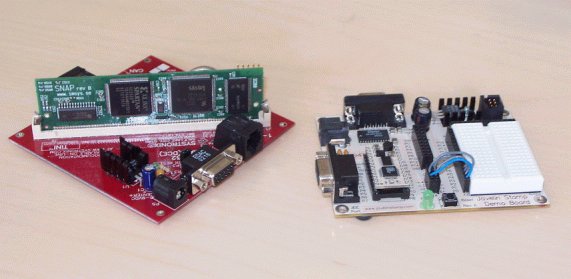|
A number of Java board level systems are available today. These
include boards that provide more or less complete computer systems
while other boards plug into the expansion slots of carrier cards
(e.g. see SNAP in photo below), which in turn provide various types
hardware such as ethernet, digital-to-analog converters, analog-to-digitial
converters, etc. that are controlled by the processor card.
Note that many of the Java processors discussed in the Chips
and Cores sections can be obtained in evaluation
boards for experimentation and testing.
The figure below shows two such boards. The Imsys
Cjip processor comes with their SNAP
SIMM card (see below) and is shown here plugged into a Systronix
socket board. The other board holds the Parallax Javelin Stamp and
includes a breadboard for experimenting with circuits controlled
by the Javelin. Both boards include serial ports for I/O.

Evaluations boards for the Imsys SNAP (left), showing the SIMM
card that follows the TINI format, and for the Parallax Javelin
Stamp (right). The SNAP SIMM (vertical green colored card) is
plugged into a Systronix
TILT carrier board, which provides a serial line connector,
Ethernet, etc. (Photo: Th. Lindblad)
Java Board Level Systems
TINI
- Tiny INterent Interface - Dallas
Semiconductor/Maxim
The TINI specification, developed by Dallas Semiconductor (now
Maxim),
aims to bring a network connection along with high level control
and monitoring capabilities to devices ranging from industrial
processing equipment to consumer appliances . The TINI interface
comes in a small, low power package yet implements a complete
TCI/IP node and an embedded Java server.
The TINI reference specification consists of a JVM running in
a microcontroller and providing Ethernet and serial communications,
all in a 72-pin SIMM package. Memory includes EEPROM for the OS
and other critical system code and static RAM (with optional battery
backup) to hold programs and the JVM heap. Peripherals can also
be mapped into memory space. The TINI card plugs into a second
board, such as a Eurocard E10, that provides the connectors for
serial and Ethernet communications.
By embedding Java and a network connection in a remote device
with a TINI system, it opens up a wide range of new capabilities.
As discussed in Chapters
14 and 15,
a server can provide monitoring and control to a distant client.
Potentially every major device in a complex industrial automation
facility or in a large scientific experiment could "go on line".
Reference Loomis gives a detailed example
of a remote data logger running on a TINI platform. The code given
allows for running TCP/IP with either Ethernet or dial up networking
using a PPP (Point to Point Protocol) network interface via serial
I/O. This would allow a remote sensor, for example, periodically
to contact a home base by telephone to download data, report on
the status of the sensor, and so forth.
SNAP
(Simple Network Application Platform) - Imsys
The SNAP card from Imsys in Sweden comes as a TINI compatible
SIMM card but instead of a conventional microcontroller running
a JVM it uses the company's Cjip Java hardware
processor. This provides for significant improvement in processing
speed. The board provides expanded capabilities compared to the
TINI reference system. It holds 2MB of flash memory and 8MB of
DRAM. The system allows for the complete J2ME CLDC configuration.
We later discuss programming the SNAP
and give an example of a Web
server running on the board.
aJ-PC104
Single Board Computer - aJile
Systems
The aJ-PC104 board from aJile Systems follows the popular PC/104
format and includes the companies aJ-100 Java processor (see above.)
It can act as a standalone Java computer or fit into a PC/104
stack.
The company also provides an evaluation board: aJ-100EVB.
Javelin
Stamp - Parallax
See the Javelin section and the Java
Chips: Javelin Interpreter.
JStik
- Systronix
This board also uses the 32-bit aJ-100
processor from aJile Systems.
It holds up to 8 MB of memory, accessible via a 32-bit wide bus.
A JSimm
expansion bus provides for connections to other Systronix Java
boards.
JSstamp
- Sytronix
This board comes as a 24-pin DIP module similar to the Javelin
Stamp (and Basic Stamp modules) but uses the aJile
Systems aJ-80 chip instead. This processor provides for the
full J2ME CLDC capability, rather than a subset of bytecode instructions
as with the Javelin.
EJC
(Embedded Java Controller) - Snijder
Micro Systems
The EW1A module is a complete, single board computer in a SO-DIMM
format. The EW1A uses a 32-bit ARM processor and comes with a
variety of I/O interfaces including Ethernet, RS232, RS485, I2C,
and Dallas 1-wire. The SK1
carrier module provides the physical connectors.
The software
incorporates Java via the Tao Group's intent
platform that comprises a real-time operating system and a JVM.
Java programs arealways translated to native machine code before
execution so they run at full native speeds.
The system
includes a full-fledged Java HTTP server that can run Java servlets.
The class library also provides for access to low level systems
such as raw memory and I/O ports. RT performance is maintained
by mapping threads to the RTOS lightweight processes and the garbage
collector is interruptable.
Jopcore
Boards
Implementing the JOP processor core,
several boards are available based on Altera FPGAs. These include
a ACEX FPGA board
and a Cyclone
FPGA board. There are add-on cards to provide ethernet, analog
I/O, prototyping, etc.
References & Web Resources
Latest update: Dec. 14, 2004
|

